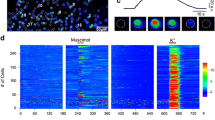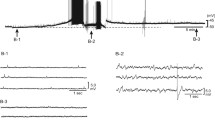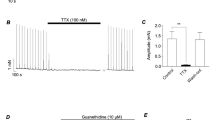Abstract
Sympathetic neurotransmitter release and its modulation by presynaptic muscarinic heteroreceptors were studied in mouse iris–ciliary bodies. Tissue preparations were preincubated with 3H-noradrenaline and then superfused and stimulated electrically. Firstly, experimental conditions were defined, allowing study of presynaptic sympathetic inhibition in mouse iris–ciliary body. If tissue was stimulated four times with 36 pulses/3 Hz, tritium overflow peaks were reliably and reproducibly measured. As expected, these stimulation conditions led to marked α2-autoinhibition as indicated by the release-enhancing effect of the α2-antagonists phentolamine and rauwolscine. To ensure autoinhibition-free 3H-noradrenaline release, which is optimal for studying presynaptic sympathetic inhibition, α2-receptors were blocked in all subsequent experiments. Under these conditions, evoked tritium overflow was almost completely abolished in the presence of the sodium channel blocker tetrodotoxin, indicating a neuronal origin of 3H-noradrenaline release. Secondly, muscarinic inhibition of 3H-noradrenaline release was characterized using the conditions described above (36 pulses/3 Hz; phentolamine 1 μM and rauwolscine 1 μM throughout). The muscarinic receptor agonist oxotremorine M decreased evoked tritium overflow in a concentration-dependent manner with an IC50 of 0.33 μM and maximal inhibition of 51%. The concentration–response curve of oxotremorine M was shifted to the right by the muscarinic antagonists ipratropium and methoctramine, whereas pirenzepine was ineffective. The observed rank order of antagonist potencies, ipratropium > methoctramine > pirenzepine, which is typical for the M2 subtype, indicates that presynaptic muscarinic receptors on sympathetic axons of mouse iris–ciliary bodies are predominantly M2. Finally, inhibition of 3H-noradrenaline release by endogenously secreted acetylcholine was investigated. Longer pulse trains, 120 pulses/3 Hz and 600 pulses/5 Hz, were used and the cholinesterase inhibitor physostigmine was added to the superfusion medium to increase synaptic levels of endogenous acetylcholine. Under these conditions, ipratropium approximately doubled the evoked overflow of tritium, indicating that endogenously released acetylcholine can activate presynaptic muscarinic heteroreceptors. In conclusion, the present experiments establish measurement of the electrically induced release of 3H-noradrenaline from mouse iris–ciliary bodies. As in other species, noradrenaline release in this preparation was subject to presynaptic muscarinic inhibition. Our results also indicate that the presynaptic muscarinic receptors on sympathetic axons in mouse iris–ciliary body are predominantly M2. Moreover, these receptors can be activated by both exogenous agonists and endogenously released acetylcholine and, hence, may operate physiologically in the interplay between the parasympathetic and sympathetic nervous system.





Similar content being viewed by others
References
Alexander SPH, Mathie A, Peters JA (2001) TiPS receptor and ion channel nomenclature supplement 2001. Elsevier, Cambridge
Altmann JD, Trendelenburg AU, MacMillan L, Bernstein D, Limbird L, Starke K, Kobilka BK, Hein L (1999) Abnormal regulation of the sympathetic nervous system in α2A-adrenergic receptor knockout mice. Mol Pharmacol 56:154–161
Boehm S, Kubista H (2002) Fine tuning of sympathetic transmitter release via ionotropic and metabotropic presynaptic receptors. Pharmacol Rev 54:43–99
Bognar IT, Pallas S, Fuder H, Muscholl E (1988) Muscarinic inhibition of [3H]-noradrenaline release on rabbit iris in vitro: effects of stimulation conditions on intrinsic activity of methacholine and pilocarpine. Br J Pharmacol 94:890–900
Bognar IT, Baumann B, Dammann F, Knöll B, Meincke M, Pallas S, Fuder H (1989) M2 muscarinic receptors on the iris sphincter muscle differ from those on iris noradrenergic nerves. Eur J Pharmacol 163:263–274
Bognar IT, Altes U, Beinhauer C, Kessler I, Fuder H (1992) A muscarinic receptor different from the M1, M2, M3 and M4 subtypes mediates the contraction of the rabbit iris sphincter. Naunyn-Schmiedebergs Arch Pharmacol 345:611–618
Burke JA, Potter DE (1986) Ocular effects of a relatively selective alpha 2 agonist (UK-14,304-18) in cats, rabbits and monkeys. Curr Eye Res 5:665–676
Caulfield MP, Birdsall NJM (1998) International Union of Pharmacology. XVII. Classification of muscarinic acetylcholine receptors. Pharmacol Rev 50:279–290
Chu E, Chu TC, Potter DE (1999) Potential sites of action of TNPA: a dopamine-2 receptor agonist. Exp Eye Res 69:611–616
Costa M, Majewski H (1991) Evidence for facilitatory and inhibitory muscarinic receptors on postganglionic sympathetic nerves in mouse isolated atria. Br J Pharmacol 102:855–860
Crosson CE, Gray T (1997) Response to prejunctional adenosine receptors is dependent on stimulus frequency. Curr Eye Res 16:359–364
Dammann F, Fuder H, Giachetti A, Giraldo E, Kilbinger H, Micheletti R (1989) AF-DX 116 differentiates between prejunctional muscarine receptors located on noradrenergic and cholinergic nerves. Naunyn-Schmiedebergs Arch Pharmacol 339:268–271
Drago F, Gorgone G, Spina F, Panissidi G, Dal Bello A, Moro F, Scapagnini U (1980) Opiate receptors in the rabbit iris. Naunyn-Schmiedebergs Arch Pharmacol 315:1–4
Farnebo LO, Hamberger B (1970) Effects of desipramine, phentolamine and phenoxybenzamine on the release of noradrenaline from isolated tissues. J Pharm Pharamcol 22:855–857
Farnebo LO, Hamberger B (1971) Drug-induced changes in the release of [3H]-noradrenaline from field stimulated rat iris. Br J Pharmacol 43:97–106
Fuder H (1994) Functional consequences of prejunctional receptor activation or blockade in the iris. J Ocul Pharmacol 10:109–123
Fuder H, Muscholl E (1995) Heteroreceptor-mediated modulation of noradrenaline and acetylcholine release from peripheral nerves. Rev Physiol Biochem Pharmacol 126:265–412
Fuder H, Muth U (1993) ATP and endogenous agonists inhibit evoked [3H]-noradrenaline release in rat iris via A1 and P2Y-like purinoreceptors. Naunyn-Schmiedebergs Arch Pharmacol 348:352–357
Fuder H, Schöpf J, Unckell J, Wesner MT, Melchiorre C, Tacke R, Mutschler E, Lambrecht G (1989) Different muscarine receptors mediate the prejunctional inhibition of [3H]-noradrenaline release in rat or guinea-pig iris and the contraction of the rabbit iris sphincter muscle. Naunyn-Schmiedebergs Arch Pharmacol 345:611–618
Fuder H, Brink A, Meincke M, Tauber U (1992) Purinoceptor-mediated modulation by endogenous and exogenous agonists of stimulation-evoked [3H]-noradrenaline release on rat iris. Naunyn-Schmiedebergs Arch Pharmacol 345:417–423
Furchgott RF (1972) The classification of adrenoceptors (adrenergic receptors). An evaluation from the standpoint of receptor theory. In: Blaschko H, Muscholl E (eds) Catecholamines. Handbook of experimental pharmacology, vol 33. Springer, Berlin Heidelberg New York, pp 283–335
Göbel I, Trendelenburg AU, Cox SL, Meyer A, Starke K (2000) Electrically evoked release of [3H]noradrenaline from mouse cultured sympathetic neurons: release-modulating heteroreceptors. J Neurochem 75:2087–2094
Harris LC, Awe SO, Opere CA, LeDay AM, Ohia SE (2002) Pharmacology of serotonin receptors modulating electrically-induced [3H]-noradrenaline release from isolated mammalian iris–ciliary bodies. J Ocul Pharmacol Ther 18:339–348
Hein L (2001) Transgenic models of α2-adrenergic receptor subtype function. Rev Physiol Biochem Pharmacol 142:161–185
Hein L, Altman JD, Kobilka BK (1999) Two functionally distinct α2-adrenergic receptors regulate sympathetic neurotransmission. Nature 402:181–184
Jumblatt JE (1994) Prejunctional alpha 2-adrenoceptors and adenylyl cyclase regulation in the rabbit iris–ciliary body. J Ocul Pharmacol 10:617–621
Jumblatt JE, Hackmiller RC (1990) Potentiation of norepinephrine secretion by angiotensin II in the isolated rabbit iris–ciliary body. Curr Eye Res 9:169–176
Jumblatt JE, Hackmiller RC (1994) M2-type muscarinic receptors mediate prejunctional inhibition of norepinephrine release in the human iris–ciliary body. Exp Eye Res 58:175–180
Jumblatt JE, North GT (1988) Cholinergic inhibition of adrenergic neurosecretion in the rabbit iris–ciliary body. Invest Ophthalmol Vis Sci 29:615–620
Jumblatt JE, Liu JG, North GT (1987) Alpha-2 adrenergic modulation of norepinephrine secretion in the perfused rabbit iris–ciliary body. Curr Eye Res 6:767–777
Jumblatt JE, Ohia SE, Hackmiller RC (1993) Prejunctional modulation of norepinephrine release in the human iris–ciliary body. Invest Ophthalmol Vis Sci 34:2790–2793
Koss MC, Hey JA (1993) Prejunctional inhibition of sympathetically evoked pupillary dilatation in cats by activation of histamine H3 receptors. Naunyn-Schmiedebergs Arch Pharmacol 348:141–145
Kulkarni KH, LeDay AM, Opere CA, Ohia SE (2002) Pharmacology of prejunctional histamine receptors on sympathetic nerves in isolated mammalian irides. Invest Ophthalmol Vis Sci 43:e-abstract 1975
Langer SZ (1997) 25 years since the discovery of presynaptic receptors: present knowledge and future perspectives. Trends Pharmacol Sci 18:95–99
Limberger N, Trendelenburg AU, Starke K (1992) Pharmacological characterization of presynaptic α2-autoreceptors in rat submaxillary gland and heart atrium. Br J Pharmacol 107:246–255
Neufeld AH, Page ED (1975) Regulation of adrenergic neuromuscular transmission in the rabbit iris. Exp Eye Res 20:549–561
Nietgen GW, Schmidt J, Hesse L, Hönemann CW, Durieux ME (1999) Muscarinic receptor functioning and distribution in the eye: molecular basis and implications for clinical diagnosis and therapy. Eye 13:285–300
Ogidigben M, Chu TC, Potter DE (1993) Ocular hypotensive action of a dopaminergic (DA2) agonist, 2,10,11-trihydroxy-N-n-propylnoraporphine. J Pharmacol Exp Ther 267:822–827
Ohia SE, Jumblatt JE (1990a) Prejunctional inhibitory effects of prostanoids on sympathetic neurotransmission in the rabbit iris–ciliary body. J Pharmacol Exp Ther 255:11–16
Ohia SE, Jumblatt JE (1990b) Inhibitory effects of neuropeptide Y on sympathetic neurotransmission in the rabbit iris–ciliary body. Neurochem Res 15:251–256
Ohia SE, Jumblatt JE (1991) Prejunctional prostaglandin receptors in the human iris–ciliary body. Curr Eye Res 10:967–975
Ohia SE, Jumblatt JE (1993) Prejunctional receptors and second messengers for angiotensin II in the rabbit iris–ciliary body. Exp Eye Res 57:419–425
Opere CA, Ohia SE (1998) Prejunctional alpha2-adrenoceptors and peroxide-induced potentiation of norepinephrine release from the bovine iris. Neurochem Res 23:1093–1098
Russel KR, Potter DE (2001) Biphasic alterations of cAMP and inhibition of norepinephrine release in iris–ciliary body by bremazocine. J Pharmacol Exp Ther 298:941–946
Schlicker E, Göthert M (1998) Interactions between the presynaptic α2-autoreceptor and presynaptic inhibitory heteroreceptors on noradrenergic neurones. Brain Res Bull 47:129–132
Shara M, Kulkarni KH, Ohia SE (2002) Effect of cannabinoids on sympathetic neurotransmission in isolated bovine irides. Invest Ophthalmol Vis Sci 43:e-abstract 3273
Somogyi GT, de Groat WC (1990) Modulation of the release of [3H]norepinephrine from the base and body of the rat urinary bladder by endogenous adrenergic and cholinergic mechanisms. J Pharmacol Exp Ther 255:204–210
Starke K (1987) Presynaptic α-autoreceptors. Rev Physiol Biochem Pharmacol 107:73–146
Trendelenburg AU, Sutej I, Wahl CA, Molderings GJ, Rump LC, Starke K (1997) A re-investigation of questionable subclassifications of presynaptic α2-autoreceptors: rat vena cava, rat atria, human kidney and guinea-pig urethra. Naunyn-Schmiedebergs Arch Pharmacol 356:721–737
Trendelenburg AU, Hein L, Gaiser EG, Starke K (1999) Occurrence, pharmacology and function of presynaptic α2-autoreceptors in α2A/D-adrenoceptor-deficient mice. Naunyn-Schmiedebergs Arch Pharmacol 360:540–551
Trendelenburg AU, Cox SL, Schelb V, Klebroff W, Khairallah L, Starke K (2000) Modulation of 3H-noradrenaline release by presynaptic opioid, cannabinoid and bradykinin receptors and β-adrenoceptors in mouse tissues. Br J Pharmacol 130:321–330
Trendelenburg AU, Klebroff W, Hein L, Starke K (2001) A study of presynaptic α2-autoreceptors in α2A/D-, α2B-, α2C-adrenoceptor-deficient mice. Naunyn-Schmiedebergs Arch Pharmacol 364:117–130
Trendelenburg AU, Philipp M, Meyer A, Klebroff W, Hein L, Starke K (2003a) All three α2-adrenoceptor types serve as autoreceptors in postganglionic sympathetic neurons. Naunyn-Schmiedebergs Arch Pharmacol 368:504–512
Trendelenburg AU, Gomeza J, Klebroff W, Zhou H, Wess J (2003b) Heterogeneity of presynaptic muscarinic receptors mediating inhibition of sympathetic transmitter release: a study with M2- and M4-receptor-deficient mice. Br J Pharmacol 138:469–480
Waud DR (1976) Analysis of dose–response relationships. In: Narahshi T, Bianchi CP (eds) Advances in general and cellular pharmacology, vol 1. Plenum, New York, pp 145–178
Wess J (2003) Novel insights into muscarinic acetylcholine receptor function using gene targeting technology. Trends Pharmacol Sci 24:414–420
Author information
Authors and Affiliations
Corresponding author
Rights and permissions
About this article
Cite this article
Bernhard, M., Takeda, K., Keller, C. et al. 3H-noradrenaline release from mouse iris–ciliary body: role of presynaptic muscarinic heteroreceptors. Naunyn-Schmiedeberg's Arch Pharmacol 370, 305–313 (2004). https://doi.org/10.1007/s00210-004-0972-z
Received:
Accepted:
Published:
Issue Date:
DOI: https://doi.org/10.1007/s00210-004-0972-z




